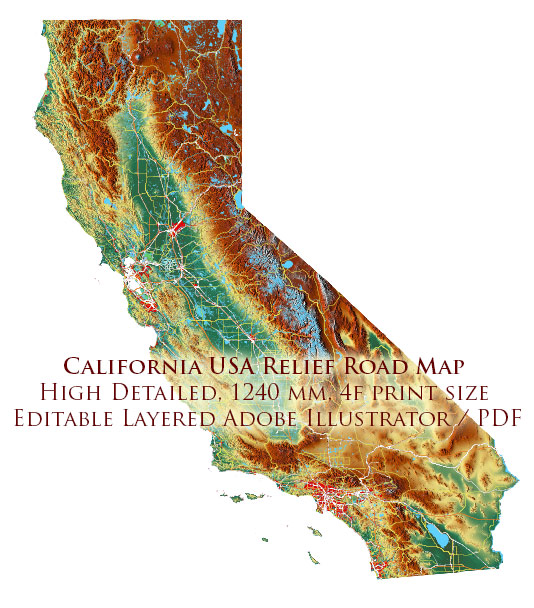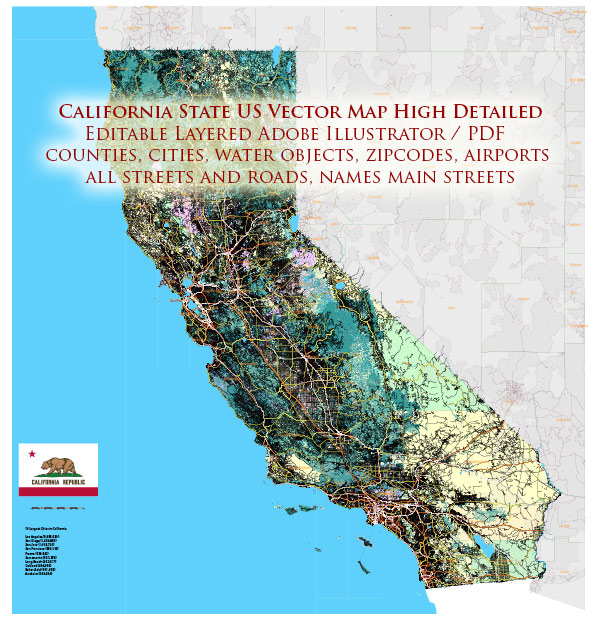The history of California’s road system is rich and complex, reflecting the state’s growth and development over the years. The evolution of California’s roads can be traced through various stages, from the early trails used by Native Americans to the modern, extensive highway network that characterizes the state today.
Vectormap.Net provide you with the most accurate and up-to-date vector maps in Adobe Illustrator, PDF and other formats, designed for editing and printing. Please read the vector map descriptions carefully.
- Pre-European Settlement: Native American Trails Before European settlers arrived, Native American tribes in California used a network of trails for trade, hunting, and communication. These trails later became the basis for some of the state’s early roads.
- Spanish and Mexican Periods (1769-1848): El Camino Real The Spanish colonization of California began in 1769, with the establishment of missions and presidios. El Camino Real, meaning “The Royal Road,” connected these missions, pueblos, and presidios. It stretched from San Diego to Sonoma, and while it was not a modern road, it played a crucial role in California’s early transportation infrastructure.
- Gold Rush Era (1848-1855): Boomtowns and Plank Roads The discovery of gold in 1848 led to a massive influx of people to California. This prompted the need for better transportation routes to connect booming mining towns. Plank roads, made of wooden planks, were constructed in some areas to facilitate travel and commerce.
- Railroads (1860s-1880s): Expanding Transportation Networks The completion of the First Transcontinental Railroad in 1869 revolutionized transportation in California. Railroads became a dominant mode of travel and freight transport. The rail network expanded rapidly, connecting major cities and facilitating economic development.
- Early 20th Century: Automobiles and the Rise of Highways The advent of automobiles in the early 20th century led to the demand for improved road infrastructure. The State Highway Act of 1895 marked the beginning of state involvement in road construction. The development of the Pacific Highway and the Lincoln Highway, both passing through California, further spurred road construction.
- California State Highway System (1920s): Highway Development The California State Highway System was established in the 1920s, designating important routes and laying the foundation for the state highway network. During this period, iconic highways like Route 66 and the Pacific Coast Highway were developed, contributing to California’s automotive culture.
- Post-World War II (1940s-1960s): Freeways and Suburban Expansion The post-war period saw significant growth in California’s population, leading to increased traffic congestion. To address this, the state invested heavily in freeway construction, with the development of the Interstate Highway System. This era also witnessed suburban expansion and the rise of car culture.
- Late 20th Century to Present: Modernization and Maintenance California’s highway system has continually evolved to accommodate the state’s growing population and changing transportation needs. Ongoing efforts focus on modernization, safety improvements, and environmental considerations. Highways such as I-5, I-10, and I-80 remain crucial arteries for transportation and commerce.
Today, California boasts an extensive network of highways, connecting urban centers, agricultural regions, and scenic destinations. The state continues to invest in transportation infrastructure, including projects aimed at reducing congestion, promoting sustainability, and adapting to emerging technologies.



 Author: Kirill Shrayber, Ph.D.
Author: Kirill Shrayber, Ph.D.